DFI CFX3200-DR: ATI RD580 Tweak Attack
by Wesley Fink on May 8, 2006 12:05 AM EST- Posted in
- Motherboards
CrossFire Gaming Performance
The RD580 chipset brings ATI Dual X16 CrossFire video to the marketplace, so both the major players in the video market now have flagship dual X16 solutions. SLI and CrossFire are about gaming, so CrossFire tests were confined to gaming benchmarks, and the test suite is heavily slanted to recent and popular titles where SLI and CrossFire make the biggest difference.However, the practical reality today is that NVIDIA SLI only works on NVIDIA boards, and ATI CrossFire works on ATI and Intel boards. This limits our ATI Dual X16 testing to CrossFire. All CrossFire testing was at 1600x1200, 4X AA, and 8X AF. Tests were also run with a single X1900XT at this same resolution. The single video results are included for reference in the results for each game. Single video results on the DFI CFX3200 are in Orange and the DFI CrossFire results are in Red.
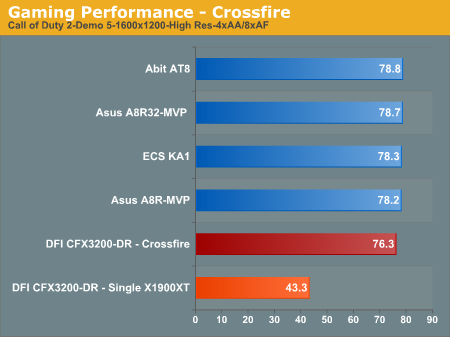
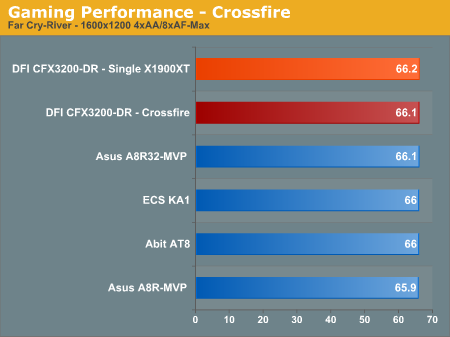
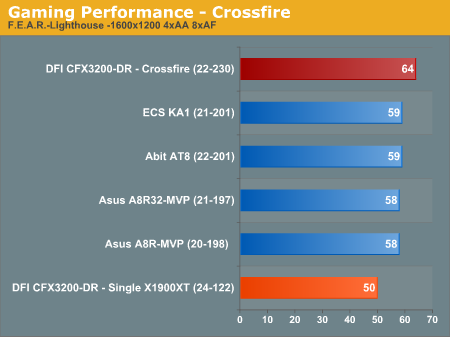
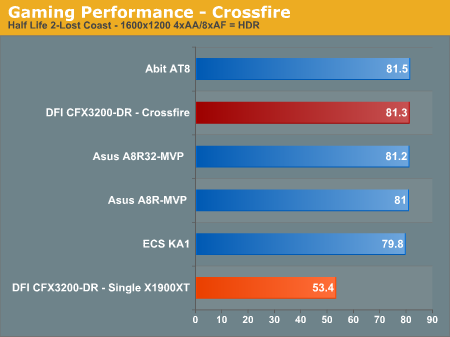
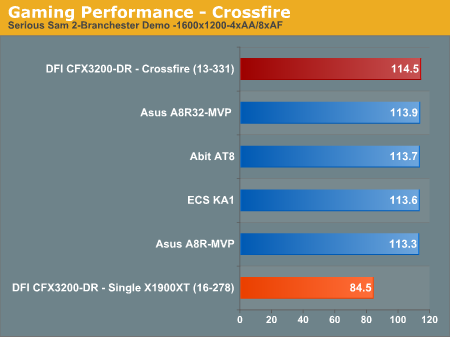
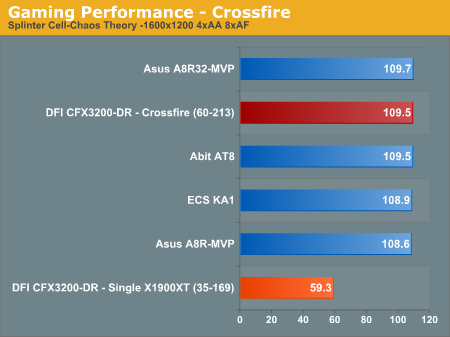
With 4X AA and 8X AF turned on at 1600x1200 resolution, CoD2, SS2, HL2LC and SCCT all show huge performance gains with CrossFire. There are smaller, but still significant gains with F.E.A.R. in CrossFire. However, look closely and you will see that Far Cry shows no improvement at all with a CrossFire platform compared to a single X1900XT, showing that this older title is CPU limited with the latest graphics cards. The DFI CFX3200 was generally a very good performer in CrossFire mode, topping the comparisons in most benchmarks. After all the early issues with the RDX200 and CrossFire this should be welcomed news for potential buyers.
We complained about ATI's CrossFire interface in our last CrossFire review, and it still remains clumsy and anything but intuitive. To use CrossFire you MUST install Catalyst Control Center. If CCC is not installed CrossFire will not work. Since many users don't install CCC (due to the large memory footprint and an interface that quite a few people dislike), this is not an ideal solution for CrossFire. Once CCC drivers are installed, you must also get the latest DirectX update from Microsoft - at least the February 2006 update is required, or you won't get the CrossFire tab in CCC. Then you must go into CCC, select the CrossFire tab and enable the feature.
This is a MANUAL procedure - there is no warning at all that you have a CrossFire capable board or that you have to go into CCC to enable CrossFire. NVIDIA notifies you that an SLI-capable system is installed and prompts you to enable SLI. There is no alert at all with ATI. The only clue you will have that CrossFire is NOT turned on is the poor performance results. THEN you start looking for what's wrong. ATI really needs to fix this issue; CrossFire performance is very good, but it would be much nicer if ATI made it easier to turn on CrossFire, as well as providing a clear way to determine that CF is functioning properly (a la NVIDIA's "Show GPU load balancing" option).










25 Comments
View All Comments
poohbear - Monday, May 8, 2006 - link
nice mobo and all, but is it really worth $240 usd?! i think that money would be better spent on a decent mobo and the savings on a better vid card.:/cornfedone - Monday, May 8, 2006 - link
WAY too expensive and no tangible performance increase over RD480 mobos.The mobo companies are out to pork consumers with sky high prices for commodity mobos. The RD480/RD580 chipsets are pretty low cost chipsets and the mobo designs less than stellar to say the least. For that Asus, DFI, Sapphire et al are asking outrageous prices for mobos with long lists of problems. None of these mobo companies has delivered a properly functioning mobo, they provide no tech support and they don't listen to their customers. All they do is use the hardware review sites as PIMPS to SHILL products that aren't ready for Prime Time.
With no serial port, only one usable PCI slot, a $200+ price tag, Mickey Mouse board layout design, too many BIOS adjustments that have little or no benefit, lack of quality tech and customer support, etc. the DFI mobo can sit on the shelf until Hell freezes over as far as I am concerned. Anyone willing to pay $200 for a malfunctioning mobo deserves exactly what they get or don't get.
PT Barnum is still alive and flourishing in the mobo industry.
Marlowe - Monday, May 8, 2006 - link
I think the Sapphire PURE Crossfire A9RD580 suffers from the same problems as you mention. Just too many settings in bios to master. I expect you don't have the time to test this motherboard as well? I've actively worked with it to or from in three weeks now.. without even getting the HTT over 290 and get my ram to work at 2,5-3-3 settings :P Also in contrast to DFI, Sapphire has very poor bios and software support :)I might just be a n00b tho! But one should think almost a month of focus should be enough to get a computer working..
Peter - Monday, May 8, 2006 - link
And yet again, we are seeing RAM performance attributed to the chipset - on an AMD64 chipset. Page 5 says:"Optimum tRAS
In past reviews, memory bandwidth tests established that a tRAS setting of 11 or 12 was generally best for nForce2, a tRAS of 10 was optimal for the nForce3 chipset, a tRAS of 7 was optimal for the nForce4/ATI RD480/ULi M1697 chipsets, and a tRAS of 10 produced the best bandwidth on the ULi 1695. The ASUS A8R32-MVP review established that a tRAS setting of 8 produced the highest bandwidth on the RD580 chipset."
Hello? As has been pointed out numerous times with those articles (every time, in fact), and as you certainly know, chipsets on AMD64 platforms do not even connect to the RAM. The CPU does that. Paragraphs like the above quoted are just plain nonsense.
Dear reviewers, are we being thick or are we just stuck too deeply in cut&paste land? You've been dragging this silly mistake along for three years now.
regards,
Peter
JarredWalton - Monday, May 8, 2006 - link
The CPU does indeed house the memory controller, but that doesn't mean the chipset doesn't have an impact on memory timings. The point is that tRAS was tested at varying levels to determine an optimal settings. While nF4, Rx480, and M1697 got best results with tRAS set to 7, M1695 liked 10 and RD580 appears to do best with ~8. Realistically, the difference between tRAS 5 and tRAS 10 in actual applications (i.e. not memory benchmarks) is going to be less than 1 or 2%. However, it's good to be clear that we're using 2-2-2-8-1T timings because those appear to be better overall than 2-2-2-5-1T.Calin - Monday, May 8, 2006 - link
While the memory controller is on the processor (and have very little in common with the chipset), one must note that the chipset will access the memory with different purposes, like DMA (Direct Memory) access from hard drive controllers, or integrated video chipsets needs a lot of bandwidth to the memory. In this, the processor is "left outside" the transfer, and the memory controller on the processor does the copy job.I don't know why different chipsets will favour different tRAS values, but the chipset needs to access the memory controller without intervention from processor
Visual - Monday, May 8, 2006 - link
so this board has drive strength settings for everything and their mother... but is that needed? is it ever useful?if they all default to max anyway, what good is the ability to set it at 31 lower settings?
and its porbably the same with many other options - if they're set to the right value already and have a warning "do not change or your system will puke" in the comments, why do we even have those options?
Calin - Monday, May 8, 2006 - link
Maybe when set at the max value, they create "echo" in other nearby lines (disrupting other signals)JarredWalton - Monday, May 8, 2006 - link
Reaching maximum overclocks - just like fine tuning a typical BIOS - requires a lot of tweaks. Getting top performance from every memory type available using "Auto" settings is not likely to happen. You can discover through trial and error where the "sweet spot" is for your particular RAM, and you might find that it gives you and extra 100-200 MHz.For example, memory skew is mostly (as I understand it) a way of increasing stability. You tweak the memory so that signals are read/sent slightly out of phase with "default", and that can be used to compensate for higher clock speeds. You would end up adjusting skew at various overclock levels to maximize stability. Drive strength is another option for tuning the system to work optimally with your RAM and CPU at various speeds; higher voltages and clock speeds would respond differently to varying drive strengths.
The problem is, finding the optimal values for even one configuration is a trial and error process that can literally take weeks or even months. Do most people need that or even want that? Probably not. For the few that do, they'll probably love this board. That's why Wes says it would be nice to hide the less frequently used options and give them reasonable "Auto" settings. In the extreme, choosing even drive strength and DQS skew while leaving all other settings the same represents 16,744,448 potential settings (three separate drive strengths with 32 potential settings, and 511 skew settings).
The good news is that there are people out there with a better understanding of the low level details that are writing guides to help others optimize performance without testing every setting.
Clauzii - Monday, May 8, 2006 - link
It looks like CrossFire is becoming a potent and competitive subject, despite what a lot of people said a year ago, and with this board from DFI, it looks like the future is indeed bright for people who want´s ATI Crossfire or thought they didn´t.It also looks that DFI has indeed become a star in the motherboard market - especially when the outdated SATA chips get a trip to the eternal outer space silicon fields - and gets an 600 injection.
To me it also seems that these boards must be near rocksolid, since I don´t see any mentions of strange behavior - nice.
Crossfire software (CCC and the horror that belongs to it!) needs to be solved by ATI as soon as possible!! as it looks to be the only thing holding back on more people getting it.
Thanks for a Nice and pretty well written article :)